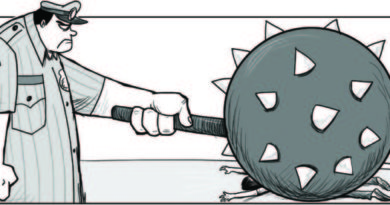Opinion | EDITORIAL : America’s 8-Step Program for Opioid Addiction – The N.Y.Times
Anthony Russo
By THE EDITORIAL BOARD | SEPT. 30, 2017
.
Opioid addiction has developed such a powerful grip on Americans that some scientists have blamed it for lowering our life expectancy.
Drug overdoses, nearly two-thirds of them from prescription opioids, heroin and synthetic opioids, killed some 64,000 Americans last year, over 20 percent more than in 2015. That is also more than double the number in 2005, and nearly quadruple the number in 2000, when accidental falls killed more Americans than opioid overdoses.
The President’s Commission on Combating Drug Addiction and the Opioid Crisis said in July that its “first and most urgent recommendation” was for President Trump to declare a national emergency, to free up emergency funds for the crisis and “awaken every American to this simple fact: If this scourge has not found you or your family yet, without bold action by everyone, it soon will.” The commission’s final report is due out in a month.
Mr. Trump has not declared an emergency, and “bold” would not describe the steps the White House has taken so far. The president’s 2018 budget request increases addiction treatment funding by less than 2 percent, even including $500 million already appropriated by Congress in 2016 under the 21st Century Cures Act.
Families across the United States are demanding that more be done to end the despair and devastation of addiction. Here are eight steps to take — now. They include some of the recommendations of the president’s commission.
<>

Weeds: The Complete Collection (Blu-ray) (Widescreen)
Highlights …. https://victoriaslists.com/index.php?page=item&id=6237
<>

Weeds: The Complete Collection (Blu-ray) (Widescreen)
Highlights …. https://victoriaslists.com/index.php?page=item&id=6237
Continue reading the main story
<>
START YOUNG WITH PREVENTION A 2015 study by the National Institute on Drug Abuse found that “Life Skills Training” for seventh graders helped them avoid misusing prescription opioids throughout their teenage years. Research suggests that life skills programs work better than traditional antidrug abuse lectures by strengthening children’s self-esteem, decision making and communication skills. In Kentucky, a state with one of the highest opioid death rates, health officials point to programs like Metamorphosis, in which counselors work with kids outdoors, using the life cycle of the Monarch butterfly to discuss choices children face as they mature.
SAVE LIVES Active users need to be kept alive long enough to seek treatment. First responders and emergency rooms lack adequate supplies of naloxone, the medication that can save someone who has overdosed on opioids, particularly fentanyl, a drug so toxic it requires multiple doses of naloxone to reverse. Both federal and state health agencies can negotiate lower prices and expand access to naloxone, and provide encouragement to the pharmacies that are already offering it prescription-free in many states. Congress can help by passing legislation to protect the responders who administer naloxone from liability. The government also needs to spend more on needle exchange and clean syringe programs to combat the infectious diseases that are associated with sharing needles.
TREAT, DON’T ARREST Nearly 300 law enforcement agencies in 31 states now participate in the Police Assisted Addiction and Recovery Initiative, which offers treatment for drug users who ask the authorities for help, an approach inspired by a program established in Gloucester, Mass. Officers work the phones to get addicts into treatment and recovery networks, in an effort that costs less and promises more lasting results than repeatedly arresting them.

FUND TREATMENT Repealing Obamacare would eliminate Medicaid-funded treatment for thousands of addicts. Republicans need to stop trying to kill the legislation and instead urge more states to adopt its Medicaid expansion, which has helped save lives in the states worst affected by the opioid crisis.
COMBAT STIGMA Misunderstanding of opioid addiction shrouds nearly every effort to reduce its toll. To help Americans — and even some physicians — appreciate the crisis, Dr. Kelly Clark, addiction psychiatrist and president of the American Society of Addiction Medicine, is calling for an effort like that used by the federal Centers for Disease Control and Prevention to fight AIDS. In the 1980s, the agency sent a brochure, “Understanding AIDS,” to every residential mailing address in the United States to dispel myths and help Americans seeking treatment. Right now, addiction medicine is a desperately needed but relatively low-status specialty. The federal government could provide tuition incentives for medical students to enter addiction-related specialties and work in underserved communities.
SUPPORT MEDICATION-ASSISTED TREATMENT One of the most effective methods of treating drug addiction is through continuing medication therapies like methadone, naltrexone and buprenorphine. Multiple studies suggest these medications help guard against relapse as well as addiction-related medical problems, allowing people to return to work and rebuild their lives. Yet fewer than a third of conventional drug treatment centers in the United States take this approach. Instead, mental health agencies place the poor in ineffective, short-term programs with no follow-up. Some halfway houses and work programs reject people on methadone or other medication-assisted treatments, saying they aren’t “recovered”; people struggling with addiction can be vulnerable to quack “cures” or exorbitant “detox” rehab stays, as can members of their families (who often foot the bills). The federal government can encourage broader acceptance of this treatment by requiring that staff physicians, physician assistants and nurse practitioners in Veterans Health Administration hospitals and federally qualified health centers receive training; that Medicaid and Medicare expand coverage of continuing medication treatment; and that medication options approved by the Food and Drug Administration be available at treatment centers that receive federal funding.

Weeds: The Complete Collection (Blu-ray) (Widescreen)
Highlights …. https://victoriaslists.com/index.php?page=item&id=6237
Continue reading the main story
<>
ENFORCE MENTAL HEALTH PARITY Half to 70 percent of people with substance abuse problems also suffer from depression, post-traumatic stress or other mental health disorders, John Renner, president of the American Academy of Addiction Psychiatry, told the president’s commission in June. The Mental Health Parity and Addiction Equity Act of 2008 prohibits insurers that cover behavioral health from providing less-favorable benefits for mental health and addiction treatment than they offer for other medical therapies or surgery. Some insurers defy the law, imposing arbitrary treatment limits or onerous authorization requirements. The federal government needs to strictly enforce the mental health parity law, a job now left largely to the states, and educate Americans about their legal rights in dealing with insurers that cheat.
TEACH PAIN MANAGEMENT The opioid crisis is rooted in our health care system: American physicians prescribe opioids for pain management at far higher rates than physicians prescribe them in any other nation. Addiction to those drugs can lead to the use of heroin and fentanyl when prescriptions run out. In California, a recent investigation by The Sacramento Bee found at least five counties in which there were more prescriptions filled for opioid painkillers last year than there were people. In Massachusetts, the state worked with dental and medical schools to ensure that all students received training in the management of prescription opioids and prevention of their misuse. The federal Department of Education could make this a national requirement for all medical students. Meanwhile, states and the federal government must continue to pursue legal action against the drugmakers whose irresponsible practices laid the foundation for this crisis.
This is by no means an exhaustive list. Strategies like “recovery high schools” for at-risk adolescents, safe injection sites and whole-family treatment programs are still being studied and debated. But the path to a national recovery from the deadliest health crisis in recent history exists.
Some have contrasted the national compassion toward the mainly white victims of opioid addiction and the government’s punishing response to the crack epidemic that devastated black communities. But let the damage done by that harshness be a lesson in how not to treat addicts. The government needs to save Americans, not cast them off.
Courtesy: New York Times
<>
NOTE : All photographs, news, editorials, opinions, information, data, others have been taken from the Internet ..aseanews.net | [email protected] |
For comments, Email to :
D’Equalizer | [email protected] | Contributor









